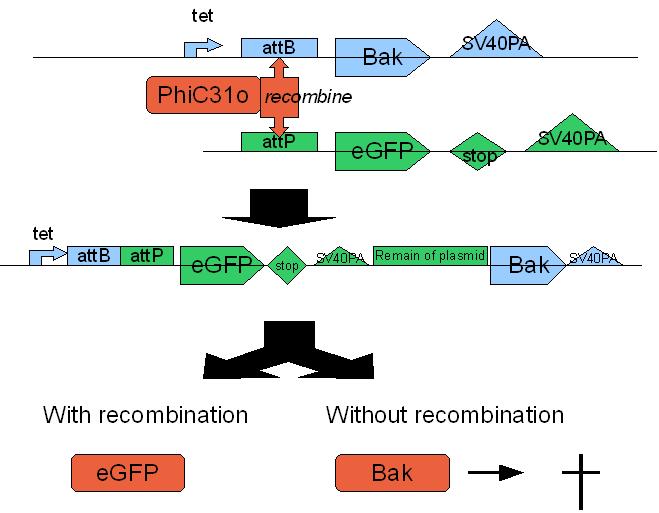Team:LMU-Munich/Jump-or-die/Functional Principle
From 2010.igem.org
(Difference between revisions)
MengzheWang (Talk | contribs) (→Jump-or-die-System) |
MengzheWang (Talk | contribs) (→Transfection possibilities) |
||
| Line 23: | Line 23: | ||
== Transfection possibilities == | == Transfection possibilities == | ||
| - | A cellline which has | + | A cellline which has construct 1 integrated into the genome will be co-transfected with construct 2 and 3. Construct 3 will be read-off instantly, in contrast to construct 1 which has to be induced by tetracycline and because of the lack of a promoter, construct 2 will at the beginning not be translated. |
| - | + | The outgoing of this co-transfection has the following possibilities: | |
| - | a) | + | a) neither constructs enter the cell |
| - | b) only construct 2 | + | b) only construct 2 enters the cell |
| - | c) only construct 3 | + | c) only construct 3 enters the cell |
| - | d) construct 2 and 3 | + | d) both construct 2 and 3 enter the cell |
| - | === a) | + | === a) neither constructs enter the cell === |
| - | If | + | If neither constructs are taken in by the cell, at the induction of the tet-on promoter, bak will be translated, the protein inserted to mitochandrial membrane and the cell will undergo apoptosis. |
| - | === b) | + | === b) only construct 2 enters the cell === |
Induction of tet-on promoter will cause translation of bak and so induce apoptosis. The gene of interest will not be read off, because there is no promoter in construct 2. | Induction of tet-on promoter will cause translation of bak and so induce apoptosis. The gene of interest will not be read off, because there is no promoter in construct 2. | ||
| Line 46: | Line 46: | ||
=== c) only construct 3 entered the cell === | === c) only construct 3 entered the cell === | ||
| - | PhiC31o will | + | PhiC31o will be translated because of the CMV promoter. But after tet-on induction bak will also be read-off and therefore cause cell death. |
=== d) construct 2 and 3 entered the cell === | === d) construct 2 and 3 entered the cell === | ||
| - | PhiC31o will be read off because of CMV promoter. Now the integrase will combine attB and attP site and integrate construct 2 into | + | PhiC31o will be read off because of CMV promoter. Now the integrase will combine attB and attP site and integrate construct 2 into the genome. Now the gene of interest lies between the tet-on promoter and bak. This complex will be translated after tetracycline induction. The doubled stop codon and polyadenylization site directly after eGFP (the gene of interest) will efficiently prevent the tranlation of bak. Thus such cells will express the gene of interest and survive. |
[[Image: Jump14.jpg | 600pxs | Jump recombination]] | [[Image: Jump14.jpg | 600pxs | Jump recombination]] | ||
Revision as of 12:46, 27 August 2010


![]()
![]()







![]()
 "
"





